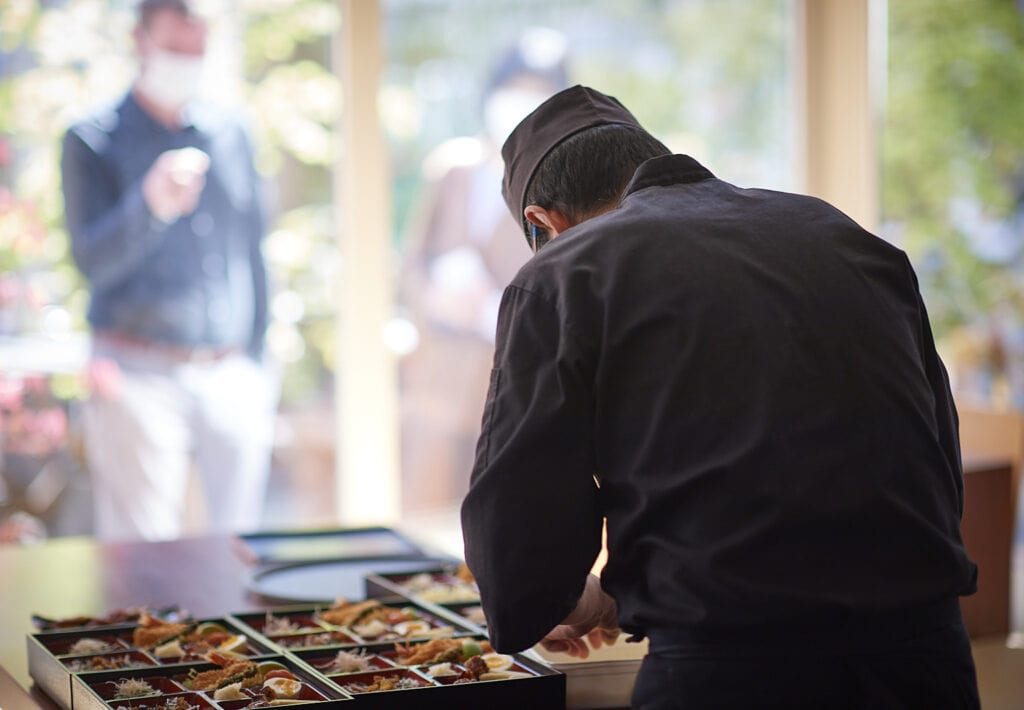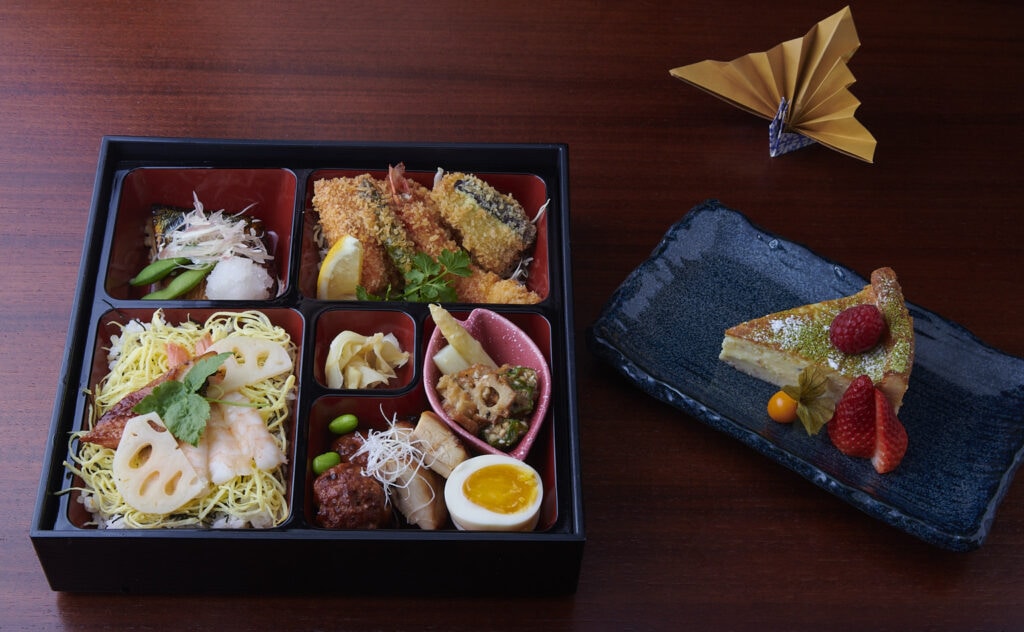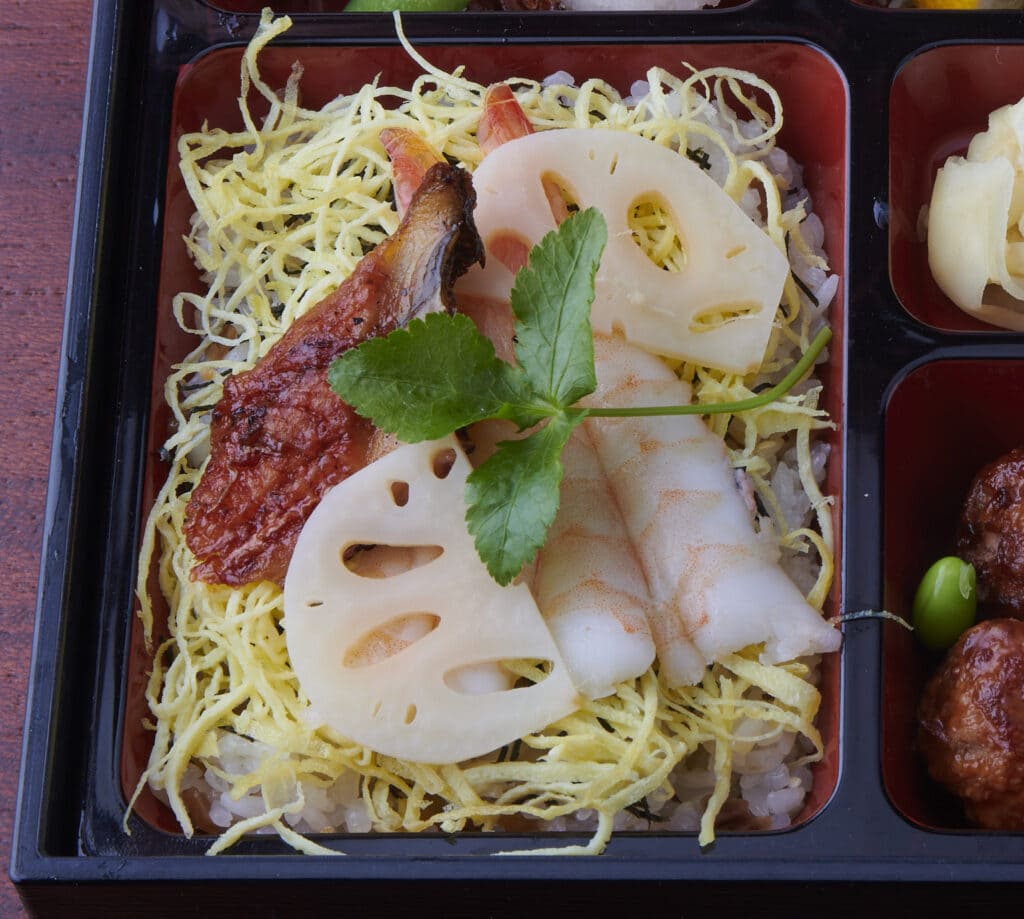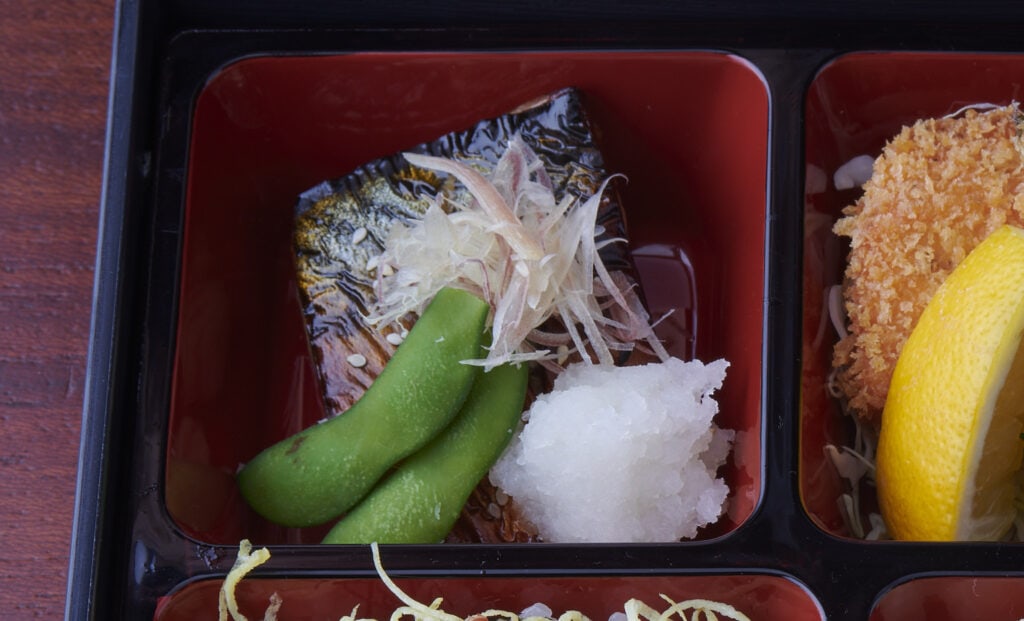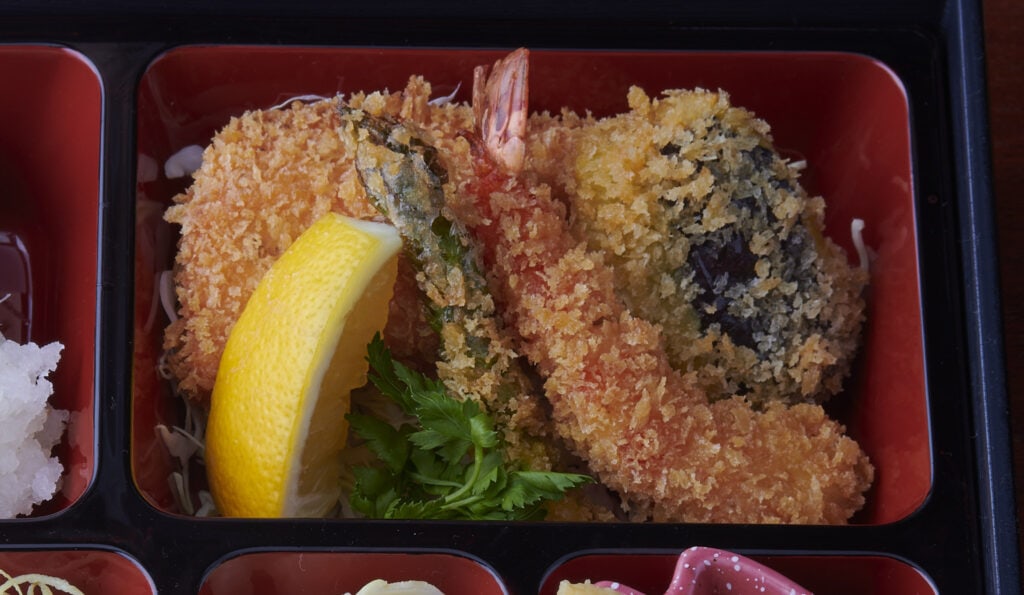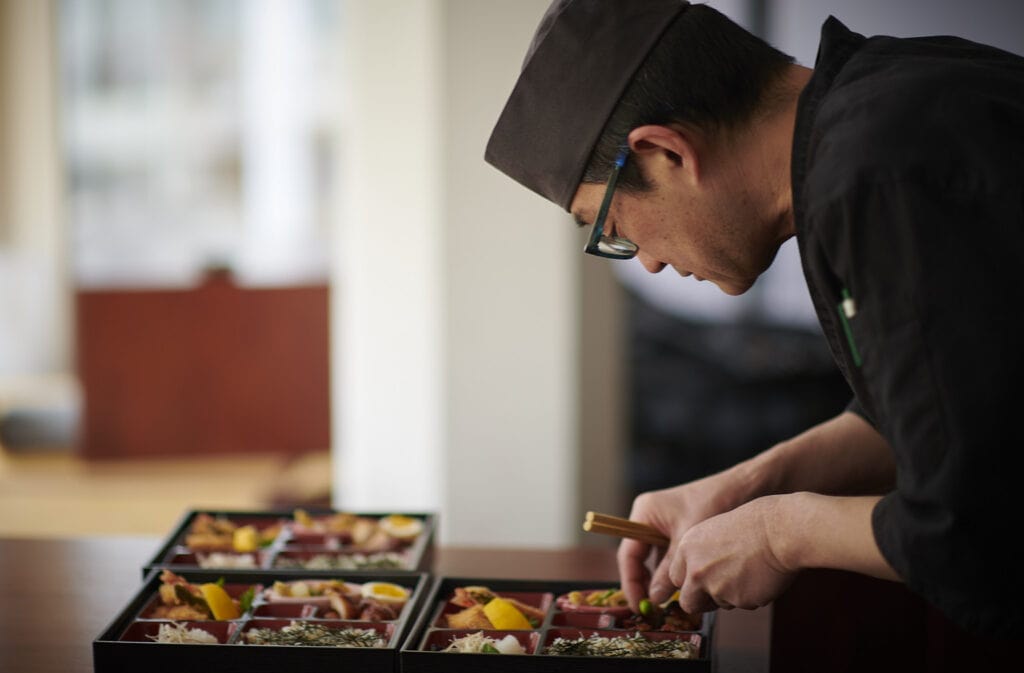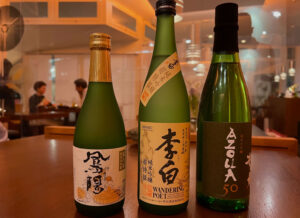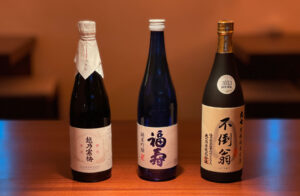Again (after our Fukiyose-Bentō March) we were allowed special Bentō for a highly esteemed Japanese clientele in Munich, this time on two occasions, which we are proud to show again here and explain for everyone's enjoyment.
Ichi-no-masu (壱の枡)
The description of the dishes starts in the lower left compartment. This is not a general rule for Bentō, where the order of the food is not fixed anyway. However, for the sake of simplicity, we currently count like this.
Chirashizushi with grilled river eel, boiled shrimp, shiitake, pickled pumpkin, lotus root. (ちらし寿司: 鰻蒲焼、えび、椎茸、干瓢、れんこん)
Donko shiitake mushrooms and kanpyo (干瓢), flavored with sweet and salty sauce, are cut into small pieces and mixed with vinegar-soaked rice to create Maze-Chirashi-zushi(まぜちらし寿司) topped with a thinly sliced omelet, fried eel, shrimp and lotus root. The different textures, acidity, sweetness, and saltiness of each ingredient spread alternately through the mouth, creating a luxurious taste unique to chirashi-zushi.
Ni-no-masu (弐の枡)
Continue in the upper left compartment, where the mackerel is hidden.
Mackerel Yuan Yaki (鯖の幽庵焼き)
Yuan-yaki is one of the most popular ways of preparing grilled fish dishes, which uses a pickling sauce called "yuan-ji" made from soy sauce, sake, mirin and lemon juice.
There is a theory that yuan-yaki was invented by Kitamura Yuan (北村祐庵,1648-1719), a tea master in Omi Province (近江,current Shiga Prefecture 滋賀県) during the Edo period (1603-1868). Yuan was a gourmet and is said to have been able to distinguish the taste of the water used for the tea ceremony.
The mackerel is marinated in yuan-ji for about two hours and then baked in the oven, with the skin coated with mirin to make the surface shiny. The fat of the mackerel harmonizes perfectly with the sweet and salty sauce of the yuan-ji. The accompanying grated daikon mixed with sweet vinegar refreshes the mouth after eating the mackerel.
San-no-masu (参の枡)
Continuing clockwise, the upper right compartment of our special Fukiyose Bentō again features some finely fried specialties.
Shrimp, salmon, green asparagus, eggplant fried in panko coating. (ミックスフライ(4種)海老・鮭・グリーンアスパラガス・茄子)
When it comes to fried dishes in Japan, in addition to tempura, the breaded and deep-fried "furai" (フライ) is also very popular as a staple in the Bentō. Tempura has been eaten in Japan since the Muromachi period (1333-1573) and is therefore a part of Japanese people's immediate culinary experience. However, deep-fried dishes are considered in Japan to be a "Yōshoku" (洋食) originally imported from the West, which originated after the Meiji period (1868-1912) when breading was introduced to Japan.
Breadcrumbs originally brought to Japan from the West were fine-grained cookies or dry bread, but the Japanese made their own breadcrumbs by crushing a loaf of bread and grinding it through a wire screen. Japanese breadcrumbs are unique because they have a light texture and contain no oil.
Japanese tonkatsu sauce (a type of thick Japanese Worcestershire sauce) goes very well with the fried dish, which retains the flavor and juicy texture of the ingredients inside while the surface becomes crispy and brown.
Yon-no-masu (肆の枡)
Finally, the lower right compartment:
Meatballs with sweet and sour sauce (肉団子甘酢餡)
Minced beef and pork are mixed with slow-roasted onions and Japanese bread crumbs, seasoned with salt and pepper, formed into meatballs and deep-fried in oil. They are then doused with a sweet and sour sauce made from vinegar, tomato ketchup, soy sauce and sugar. The sauce is then thickened with potato starch. The sweet and sour sauce combines well with the fluffy fried meatballs thanks to the effect of the breadcrumbs.
Boiled egg marinated in dashi broth (塩煮玉子)
A half-cooked egg soaked overnight in a sauce flavored with dashi, soy sauce and salt. The harmony between the egg white soaked in the sauce and the melting yolk is a perfect balance.
White asparagus Ohitashi (白アスパラガスのお浸し)
Seasonal white asparagus is quickly cooked and soaked overnight in a delicately flavored broth of dashi, light soy sauce and salt. The flavor of the bonito broth penetrates well into the sweet white asparagus. It's best to snack on the asparagus between heavily spiced dishes to create a flavor contrast.
Chicken leg grilled marinated in soy sauce (鶏モモ肉漬け焼き)
Chicken thighs soaked for four hours in a marinade flavored with soy sauce and garlic and baked in the oven. The lightly browned surface is crispy on the outside and full of juicy flavor on the inside.
Okra and chikuwa tossed in sesame seeds (オクラとちくわの胡麻和え)
"Goma-age" (胡麻和え), boiled vegetables with sesame seeds, soy sauce and sugar, is one of the classic side dishes of Japanese cuisine. This time, the chef combined two unexpected ingredients: chikuwa marinated in dashi broth and sticky okra. The soy sauce and sugar bring out the flavors of the ingredients, and the aroma of the sesame seeds ties them together.
Ko-masu (小枡)
The ginger, as always, serves only as a small flavorful change between the various dishes to be sampled.
Ginger (ガリ生姜)
The role of gari (ginger) can be summarized in two ways.
The first is to refresh the mouth. Especially after eating heavily spiced or oily fish, gari can cleanse the palate and reset the taste buds in the mouth.
The second function is its sterilizing effect. Eating ginger as a condiment for sushi with raw fish can prevent food poisoning due to the strong sterilizing power of ginger. Although there was no raw fish in this bento, the role of gari is still important for the bento, which takes a little time from preparation to delivery.
Bentō in the highest quality
Every evening we serve first-class sushi and fine Japanese cuisine in the restaurant sansaro with many organic ingredients. But on special request or for special occasions we always have other varieties of Japanese cuisine.
If you would like to order a very exclusive menu or need catering for an event, please contact us using the contact form on our website. www.sushiya.de and subscribe to our newsletter to be there when we offer another special.
